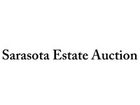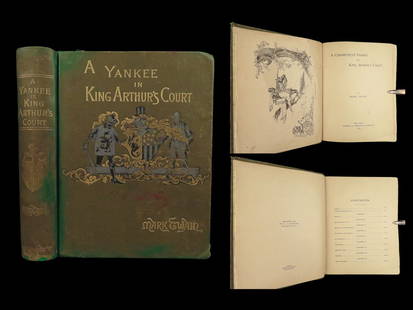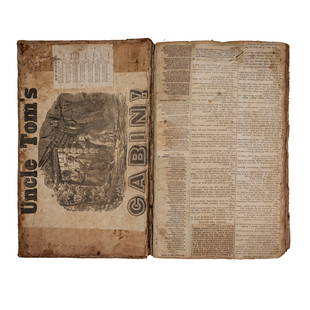
Dickens, Master Humphrey's Clock, 1st Ed 1840-41
Similar Sale History
View More Items in Books, Magazines & Papers

Related Books, Magazines & Papers
More Items in Books, Magazines & Papers
View MoreRecommended Collectibles
View More









Item Details
Description
Master Humphreys Clock, By Charles Dickens, With Illustrations By George Cattermole and Hablot Browne, London: Chapman and Hall, 186, Strand, MDCCCXL - MDCCCXLI [1840 - 1841], complete three-volume set, first edition, first issue, tall 8 vo., with the imprint of Bradbury and Evans, Printers, Whitefriars [London] on the reverse of the title page, with a dedication page to Samuel Rogers and a two-page preface, “Devonshire Terrace, York Gate, September 1840” on iv in Vol. I, “Devonshire Terrace, London, March, 1841” on vi of Vol. II, and “Devonshire Terrace, York Gate, November 1841” on vi of Vol. III, with all the points of issue called for by Eckel and Walter Smith that make this set a first edition, first issue, with gilt lettering, elaborate gilt tooling, and Roman numerals in gilt on the spine, with the original embossed brown cloth and gilt clock motifs on the front covers, and a neat device on the clocks where the hand of the clock pointed to the volume number for the book; pale yellow endpapers, with the bookplate of Kenneth Rapoport on the front free paste-down of each volume, with 306 pages in Vol I, 306 pages in Vol II, and 426 pages in Vol III; with illustrations by George Cattermole and Hablot Browne and woodcut engravings by E. Landells, C. Gray, Vasey, and S. Williams, after the designs by Cattermole and Browne; Daniel Maclise also drew one of the illustrations on page 108 in the second volume. All of the illustrations are untitled and some are unsigned, while others contain the artist’s initials or monogram, occasionally reversed, and the initials and surnames of the engravers are also appended to the illustrations in most cases (Smith page 49), and all those details are present here, as called for. There are 56 points of issue in the three volumes, according to Smith, and all 56 points are present here; Smith calls them “internal flaws”, but they are just points of issue by another name, and these points of issue make the three books a first edition, first issue set.
The yellow endpapers are also important. Many people believe that the first issue had marbled edges and marbled endpapers, but Smith (page 57) quotes Hatton and Cleaver (page 163), who said that copies with yellow endpapers and trimmed edges preceded those with marbled endpapers and marbled edges, so right now the copies with marbled endpapers are considered first edition first issues, but this set with yellow endpapers is considered a first issue set too, and it seems rarer than the sets with marbled endpapers, based on Smith’s observations. And that begs the question: If the copies with yellow endpapers preceded the other copies, does that make the copies with marbled endpapers first editions, but second issues? We don’t know the answer to the question, but it seems to be obvious, and perhaps more research needs to be done here to get the literary community to agree.
(Part of the answer seems to be in finding out exactly when the copies with yellow endpapers were first printed and when the copies with marbled endpapers were first printed, and we don’t know if research that way has been done yet.)
This is Dickens’ fifth novel and it was issued in three forms - in weekly parts, monthly parts, and the three-volume book form after all the parts were completed, and this is the first time Dickens used woodcuts in his novels; Volumes I and II also include “The Old Curiosity Shop” and Volumes II and III include “Barnaby Rudge”.
George Cattermole (1800 - 1868) was a British painter and illustrator who worked mainly in watercolours; he was also a friend of Dickens and many other literary and artistic figures, and Hablot K. Browne (1815 - 1822) was an English artist and illustrator who illustrated many of Dickens’ novels after 1836. Kenneth Rapoport was a noted book collector who amassed many rarities in literature, especially works by Rabelais, Cervantes, Shakespeare, Moliere, and English poetry and drama, according to Swann Galleries in their April 2022 auction catalogue, and his remaining book collection is housed in a separate room at Harvard University’s Houghton Library.
The boards measure 10 1/4 x 7 1/8 in. wide; Vol. I has clean text, with light bumps on the right edge of the front cover, tips slightly curled in, and a 1 in. long chip developing on the spine, Vol. II has clean text, with very light bumps at the heel and crown of the spine, three tips are slightly turned in, and Vol. III has clean text and light bumps at the edge of the rear board and small brown oval stains on the fore-edge of the book, the tips are slightly turned in, and light bumps on the crown and heel of the spine.
See The First Editions Of Charles Dickens, Their Points and Values, by John C. Eckel 1932; also Walter E. Smith, Charles Dickens In The Original Cloth, A Bibliographical
Catalogue Part I, Los Angeles: Heritage Bookshop 1982; and A Bibliography of the Periodical Works of Charles Dickens: Bibliographical, Analytical & Statistical, by Thomas Hatton and Arthur Cleaver 1933 for more information about this set.
The yellow endpapers are also important. Many people believe that the first issue had marbled edges and marbled endpapers, but Smith (page 57) quotes Hatton and Cleaver (page 163), who said that copies with yellow endpapers and trimmed edges preceded those with marbled endpapers and marbled edges, so right now the copies with marbled endpapers are considered first edition first issues, but this set with yellow endpapers is considered a first issue set too, and it seems rarer than the sets with marbled endpapers, based on Smith’s observations. And that begs the question: If the copies with yellow endpapers preceded the other copies, does that make the copies with marbled endpapers first editions, but second issues? We don’t know the answer to the question, but it seems to be obvious, and perhaps more research needs to be done here to get the literary community to agree.
(Part of the answer seems to be in finding out exactly when the copies with yellow endpapers were first printed and when the copies with marbled endpapers were first printed, and we don’t know if research that way has been done yet.)
This is Dickens’ fifth novel and it was issued in three forms - in weekly parts, monthly parts, and the three-volume book form after all the parts were completed, and this is the first time Dickens used woodcuts in his novels; Volumes I and II also include “The Old Curiosity Shop” and Volumes II and III include “Barnaby Rudge”.
George Cattermole (1800 - 1868) was a British painter and illustrator who worked mainly in watercolours; he was also a friend of Dickens and many other literary and artistic figures, and Hablot K. Browne (1815 - 1822) was an English artist and illustrator who illustrated many of Dickens’ novels after 1836. Kenneth Rapoport was a noted book collector who amassed many rarities in literature, especially works by Rabelais, Cervantes, Shakespeare, Moliere, and English poetry and drama, according to Swann Galleries in their April 2022 auction catalogue, and his remaining book collection is housed in a separate room at Harvard University’s Houghton Library.
The boards measure 10 1/4 x 7 1/8 in. wide; Vol. I has clean text, with light bumps on the right edge of the front cover, tips slightly curled in, and a 1 in. long chip developing on the spine, Vol. II has clean text, with very light bumps at the heel and crown of the spine, three tips are slightly turned in, and Vol. III has clean text and light bumps at the edge of the rear board and small brown oval stains on the fore-edge of the book, the tips are slightly turned in, and light bumps on the crown and heel of the spine.
See The First Editions Of Charles Dickens, Their Points and Values, by John C. Eckel 1932; also Walter E. Smith, Charles Dickens In The Original Cloth, A Bibliographical
Catalogue Part I, Los Angeles: Heritage Bookshop 1982; and A Bibliography of the Periodical Works of Charles Dickens: Bibliographical, Analytical & Statistical, by Thomas Hatton and Arthur Cleaver 1933 for more information about this set.
Buyer's Premium
- 26%
Dickens, Master Humphrey's Clock, 1st Ed 1840-41
Estimate $1,400 - $2,800
6 bidders are watching this item.
Shipping & Pickup Options
Item located in SARASOTA, FL, usSee Policy for Shipping
Local Pickup Available
Payment
Accepts seamless payments through LiveAuctioneers

Related Searches
TOP




















![Dickens, Master Humphrey's Clock, 1st Edition: Dickens, Charles. MASTER HUMPHREY'S CLOCK. London: Chapman and Hall, 1840-1841, Tall 8vo, 3 volumes. [4], iv, 306; vi, 306; vi, 426 pp., including frontispieces in each volume. Bound in later 19th c.](https://p1.liveauctioneers.com/3532/215986/110647566_1_x.jpg?height=310&quality=70&version=1629830116)


![Master Humphrey's Clock 85 original weekly parts: Heading: Author: Dickens, Charles Title: Master Humphrey's Clock Place Published: London Publisher:Chapman and Hall Date Published: [1840-41] Description: 1-85 (of 88) week](https://p1.liveauctioneers.com/642/120568/61385115_1_x.jpg?height=310&quality=70&version=1523629436)
![First combined edition of Humphrey's Clock: Heading: Author: Dickens, Charles Title: Master Humphrey's Clock Place Published: London Publisher:Chapman and Hall Date Published: [1840-41] Description: 3 volumes in 1. I](https://p1.liveauctioneers.com/642/266630/139202003_1_x.jpg?height=310&quality=70&version=1667495873)







![Dickens, Pickwick Papers, 1st ed.: Dickens, Charles. THE POSTHUMOUS PAPERS OF THE PICKWICK CLUB. London: Chapman and Hall, 1837. 8vo. xiv, [2], 609 pp. + 80 plates (*containing 37 extra plates, most or all of which appear to have been](https://p1.liveauctioneers.com/3532/215986/110647516_1_x.jpg?height=310&quality=70&version=1629830116)









































![George Washington Signed Discharge: Partly printed discharge document signed by George Washington, as Commander in Chief of the Armies of the United States. Newburgh, [New York], 4 January 1783. 1 page, ## x ## in. Undersigned by Washin](https://p1.liveauctioneers.com/7226/322253/173251475_1_x.jpg?height=310&quality=70&version=1710004847)



![[Ambrotype] Texas Confederate Soldier: Sixth plate ambrotype. Full leatherette case. Portrait of a possible Texas Confederate soldier. A silver star device was used to pin up the brim of his light-toned headgear, a look often seen in image](https://p1.liveauctioneers.com/7226/322253/173251509_1_x.jpg?height=310&quality=70&version=1710004847)

